Hingston Down Reservoir (2023)
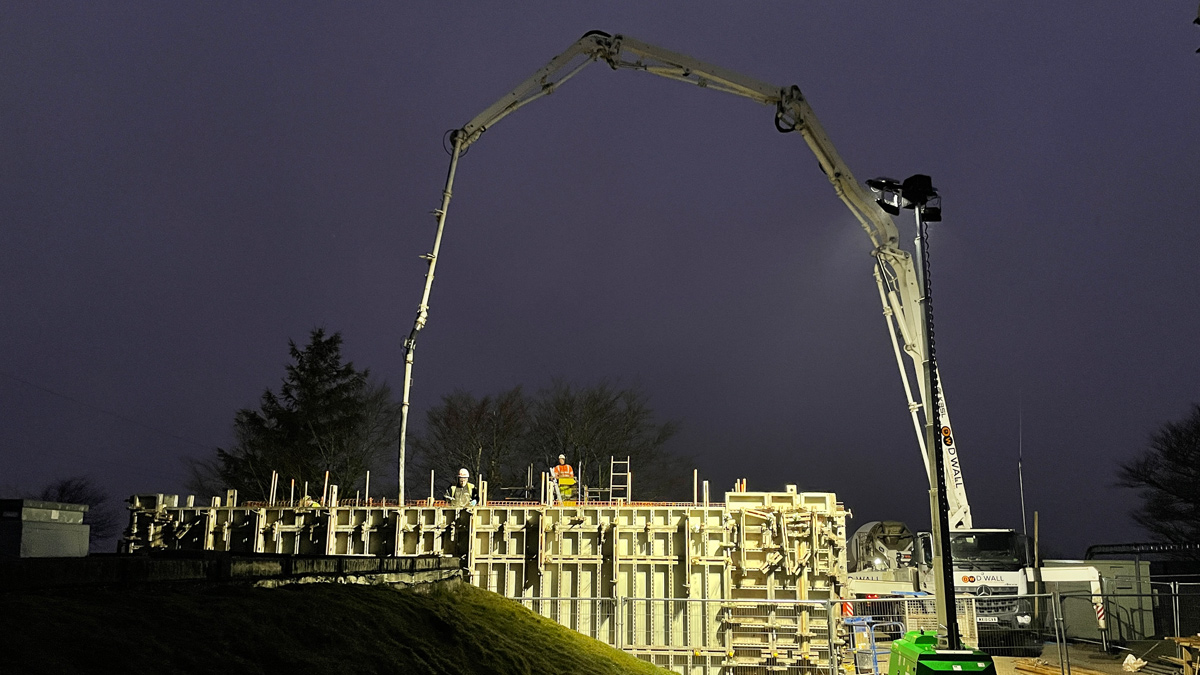
Hingston Reservoir under construction - weekend and late shift working was not uncommon - Courtesy of Galliford Try
South West Water’s (SWW) Hingston Down Reservoir site is located on an exposed Cornish hilltop and contains two service reservoirs which supply nearby villages with potable water. Originally there was only one reservoir at the site and there was no way of being able to take it out of service for cleaning, so a Braithwaite GRP storage tank was installed in the early 2000s. As the local settlements expanded, including holiday parks, the temporary tank started to become relied upon during the busy tourist season to ensure adequate water supply throughout the day, so became the second service reservoir, hydraulically linked to the original.
Project drivers
The temporary Braithwaite tank was only ever intended to be a temporary structure to aid cleaning the original reservoir. It was never designed to be maintainable in the way required by regulations. This, together with the site struggling to provide sufficient quantities of water during the busiest summer months, resulted in the requirement to replace the temporary tank with a new service reservoir with a greater capacity.
The replacement structure was to assist in providing resilience to the supply of compliant water to the network; whilst allowing maintenance to be carried out in a safe manner, under the control of SWW’s safe system of work.
Programme restraints
This project was strongly time dependant. The requirement to replace the tank was only made in the autumn of 2021, and the replacement reservoir had to be in service by Easter 2022. During the winter period, SWW believed the network could be serviced from just the existing reservoir as the main constraint was the feed pump capacity supplying the reservoir(s) and this capacity would be exceeded at the start of the Easter holiday tourist season.
Site mobilisation and demolition of the existing Braithwaite tank commenced in December 2021, with RM Penny Group employed to undertake the demolition work. The tank was broken up using a 20t excavator with a selector grab attachment. The GRP panels were ripped into manageable pieces with the stainless steel reinforcement bars segregated for recycling.
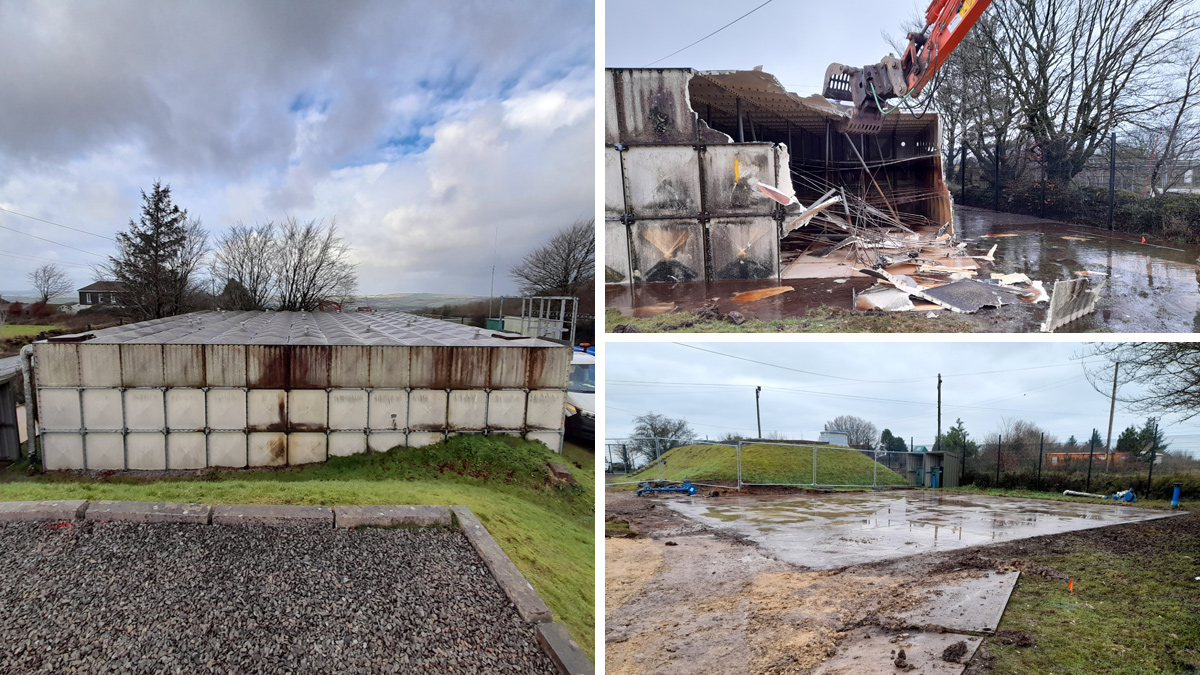
(left) The existing temporary reservoir, (top right) the demolition of the temporary tank and (bottom right) the view of site following tank removal – Courtesy of Galliford Try
Design
In order to provide greater storage capacity on site, the Galliford Try design team came up with a novel idea of using a ‘smart valve’ to link the new and old reservoirs together. An existing pumping station supplied the site but struggled to keep up with peak demand. The logic therefore was to now only pump to the new, taller reservoir and use the ‘smart valve’ to release water into the existing adjoining reservoir, keeping the original reservoir within a set of control levels. The new reservoir could then act as a balancing tank whilst also providing supply to the network.
Hingston Down Reservoir: Supply chain – key participants
- Design/construct: Galliford Try
- Civil & structural design services: Bailey Partnership
- Topographical survey: Kemp Chartered Engineering & Surveying
- Demolition & removal of existing tank: RM Penny Group
- Reinforced concrete works: D Wall Construction Services Ltd
- Fabrication: Thorne Fabrication Limited
- Pumps: Pump Supplies Ltd
- Mechanical items: Teignflex Ltd
- Mechanical & civil items: Wolseley UK
- Electrical items: Edmundson Electrical Ltd
- Wirechairs: Miers Construction Products Ltd
- Access scaffolding works: RBS Scaffolding Devon
- Diamond drilling works: 24-7 Diamond Drilling & Sawing Services
- Mechanical items: Vulcan Industrial Fasteners
- Aggregates: Hanson Aggregates
- Construction Products: Jewson
- Plant hire: Brandon Hire
- Plant hire: Sunbelt Rentals Ltd
- Plant hire: Gap Group Ltd
- Crane hire: Spence Crane Hire Ltd
- Crane hire: Macsalvors (Plant Hire) Ltd
- Civil items: Travis Perkins
- Fuel: Watson Fuels
- Haulage: Steve Wills Haulage
Construction
With the Braithwaite tank removed, the Galliford Try civils team moved on site to undertake the preparation works for the new reservoir; including the underground pipe connections. Due to the new site operating logic, numerous pipework connections and modifications had to be undertaken with the inlet and outlet pipes to the reservoir being set within the base slab.
D Wall Construction Services Ltd was employed to undertake the reinforced concrete construction works. Weekend and evening shifts were used to ensure their tight programme was maintained and to try to mitigate against the Cornish winter weather. Wind was the biggest issue, the site is located on top of a hill and with all construction having to be undertaken from just one side of the reservoir, lifting formed a large proportion of the construction process.
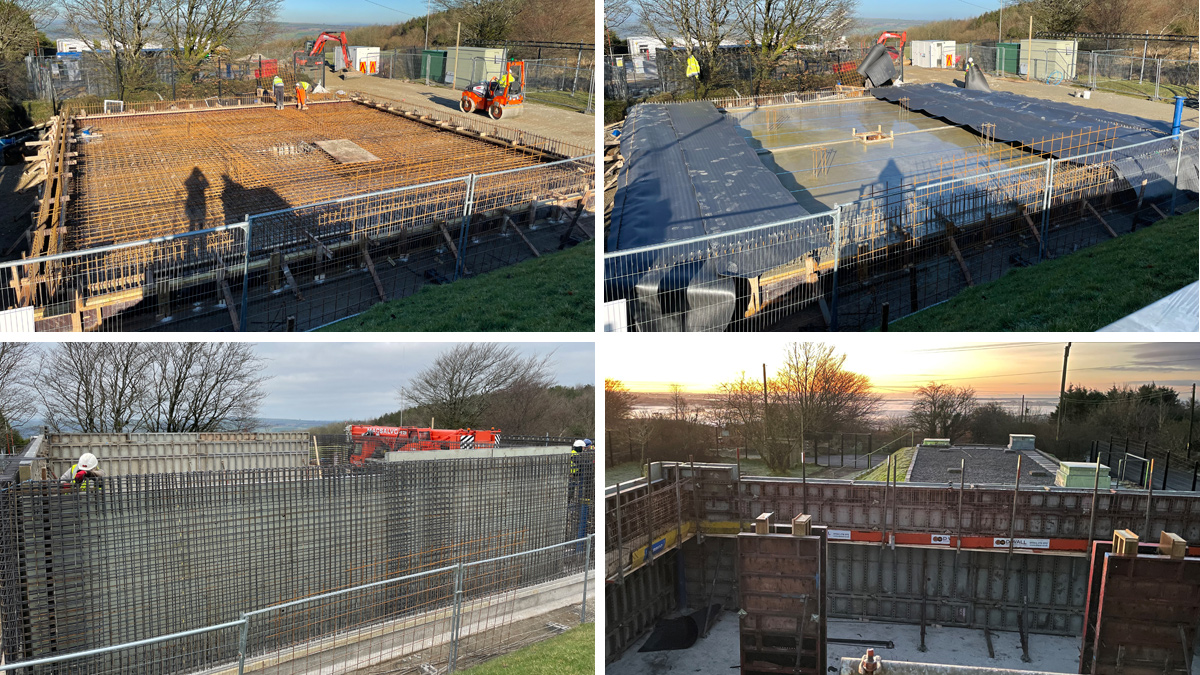
(top left) Installation of steel reinforcement for new reservoir on existing tank slab, (top right) frost blanket placement as pour undertaken late January 2022, (bottom left) steel reinforcement for tank wall with internal shutter erection and (bottom right) column and wall shutters ready for concrete pour – Courtesy of Galliford Try
Resources
Regular meetings and conversations were held by the site team with key suppliers to ensure they could hit the dates promised and any issues quickly identified and mitigated. A Critical Path (CP) Board was used to itemise each day’s activities by all suppliers, including the suppliers’ off-site activities. All interfaces between different sub-contractors were discussed to ensure nothing got in the way of the day’s planned progress, which also included when deliveries were to be made and how/where they were to be off-loaded. The SWW operational team also became heavily involved in the CP Board review sessions and this resulted in network alterations and availability of water for testing being available exactly when required.
Most deliveries were ‘just in time’, often being dropped off the day before, or even on the morning of the day of installation, so when a delivery of straight reinforcement bar was delivered curved, a solution had to be found immediately. Unfortunately, the supplier could not provide replacement steel for a few days, however another supplier located around 150 miles away could get it ready for collection the following day (which was a Saturday). Thankfully a regional member of GT was found with a van who was willing to drive to the supplier early Saturday morning and get the steel to site by lunchtime the same day, thus allowing the steel fixers to keep working to their programme.
Time saving solutions
Due to the project time restraints and coupled with the exposed site location, a cast in situ reinforced concrete reservoir was chosen, which would provide 406m3 of additional capacity to the existing reservoir. The five-month construction programme had to be cut down to three months in order to complete the works on time and resulted in a construction programme with zero time risk on the critical path. The design and delivery team therefore worked closely together to shorten the overall construction programme and employed the following solutions:
- Utilising the existing tank slab as blinding for the new structure.
- Fast-tracking panel design and construction by utilising the Galliford Try in-house panel shop.
- Working with all aspects of the supply chain for prompt deliveries and reserving manufacturing slots so that when drawings were issued, these could be slotted directly into the supply chain.
- Hiring in a shuttering system from London to allow the walls to be poured in one go rather than the four pours identified at pre-construction.
- Working with concrete batching plant to create a hybrid mix design.
- Working with SWW’s scientific department to deviate from the usual testing regime whilst still ensuring all tests were undertaken as required.
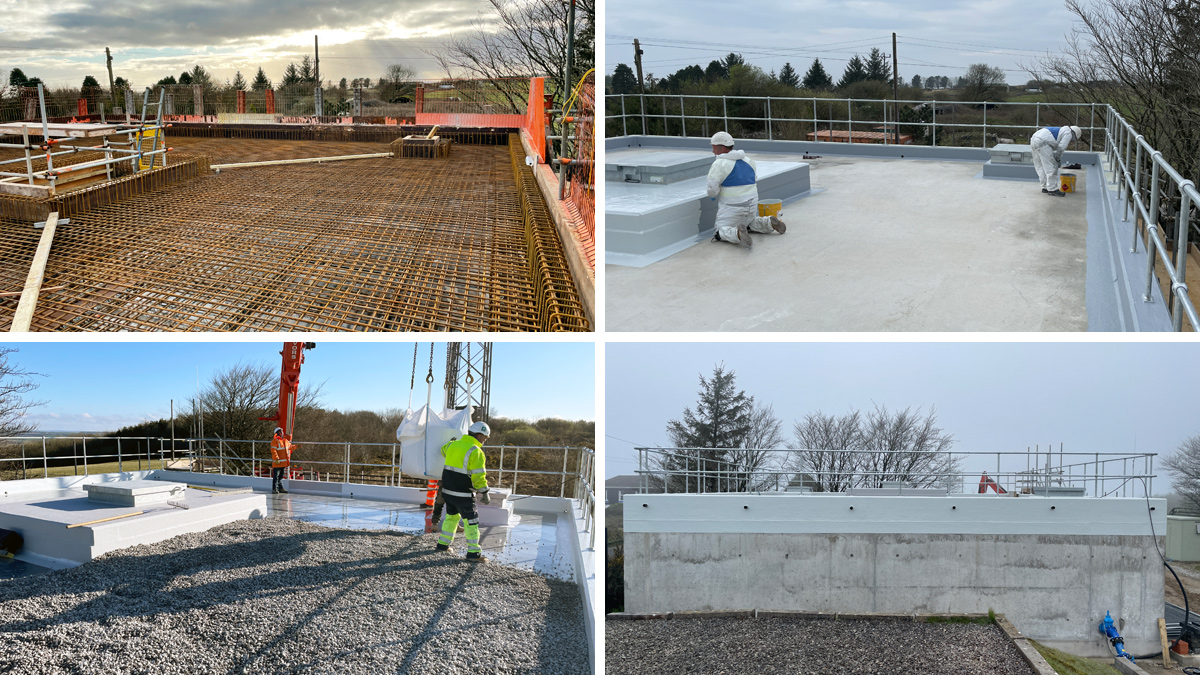
(top left) Steel reinforcement and shutters ready for roof slab pour, (top right) Application of waterproofing pain system to roof slab and top of walls/upstands, (bottom left) placement of stone cover to reservoir roof slab, and (bottom right) the new reservoir is complete and undergoing water testing – Courtesy of Galliford Try
Embedded carbon and carbon savings are very important to South West Water, so the initial concrete mix design contained a healthy element of cement replacement. This however resulted in delayed curing and it took a full three days for the base slab to cure sufficiently on this exposed site before wall and column construction could start.
Due to the crack width and other requirements for a potable water retaining structure a full 100% cement mix was not possible. The delivery and design team worked closely with the local concrete batching plant to create a blended hybrid mix which would set as fast as possible but whilst also meeting the stringent standards required for the structure. This concrete mix turned out to be so good that the lost three days were recovered in the curing time for the walls and roof slab.
By far the biggest time saving came from working with South West Water’s scientific department, which saved around three weeks off the initial tender programme. As soon as the soffit was struck, the tank was cleaned with a pressure washer and filled for the initial water test. Samples were taken after the seven day water test was complete and analysed to identify possible areas of compliance failure.
It was identified that alkalinity was an issue, (as would be expected with water contact on a new concrete structure) however there was no issue with bacteria, but a slight oil residue was detected. The oil residue was quickly identified as the shuttering release agent and it was decided to empty the tank and refill again for a further seven-day water contact period with the structure. The scientific results which came back following this test were very promising, and it was decided that no further action was required prior to the normal sterilisation and water sample testing which would be required prior to brining the reservoir into service.
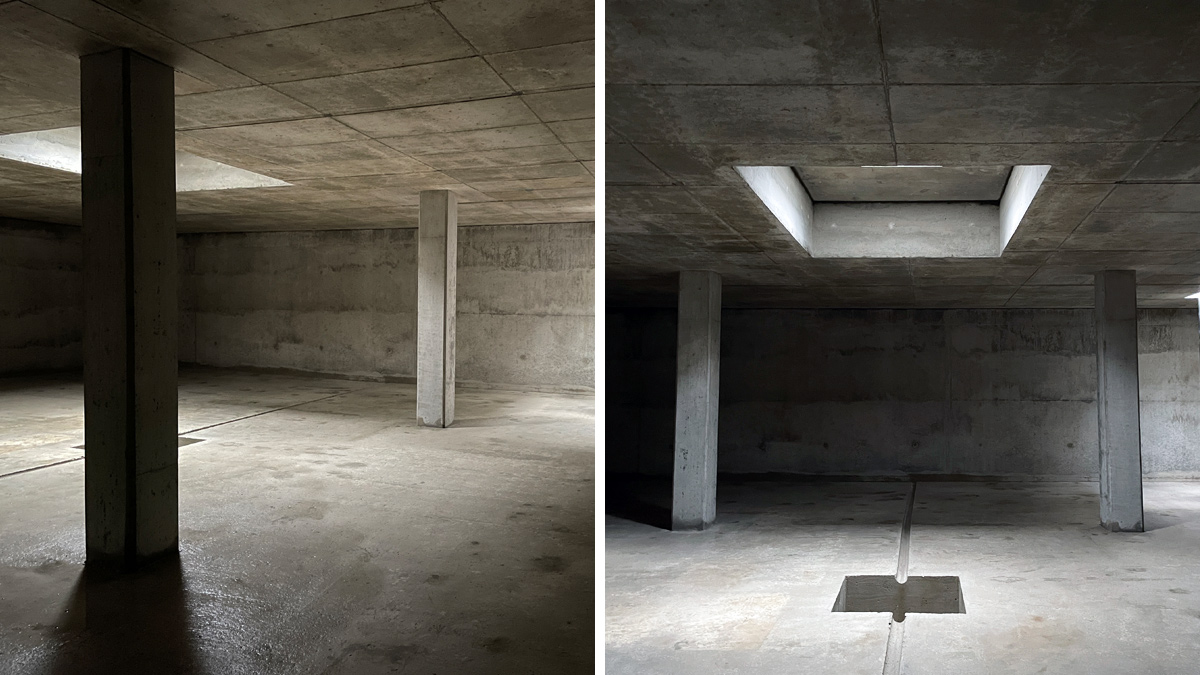
View from inside new reservoir prior to initial water test – Courtesy of Galliford Try
Customer and stakeholder
Due to the critical nature of this scheme, official progress meetings were undertaken every other week with communications and site visits from the operational team undertaken several times a week. The local community was informed of the project through letter drops and the resident who lived opposite the site was kept up to date by in-person visits from the site team.
The site is located adjacent to a mining heritage site, which is frequently visited by tourist and locals; especially dog walkers. The site team ensured they were approachable and polite and built up a great rapport with several of the locals. Key interfaces were logged by the site’s client liaison officer with summaries fed back to South West Water.
It is testament to the site team that not a single complaint was received regarding the construction activities being undertaken on the site and gifts and praise for the works undertaken were regularly received.
Completion and handover
Water testing was undertaken during a 28-day period of concrete curing which was required before the application of a polyurethane waterproofing system – a South West Water requirement – before the reservoir could be brought into service.
The waterproofing system was the last critical path item and was initially booked in with Technique (system applicators) in January of 2022. The application slot was hit by the delivery team and the reservoir handed over to South West Water on the agreed date so that the system could be brought online just at the start of the Easter holidays.




